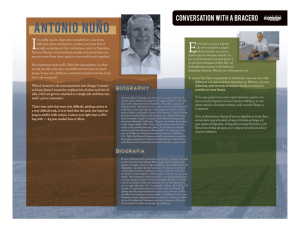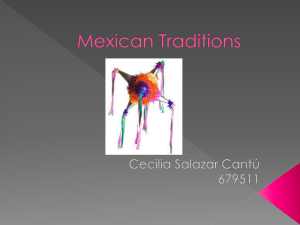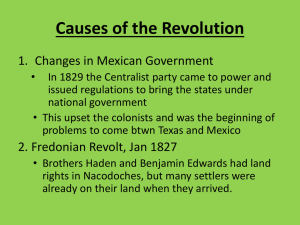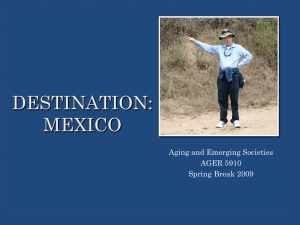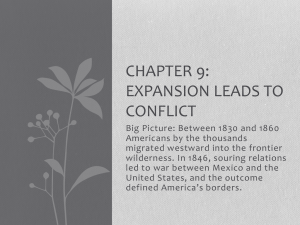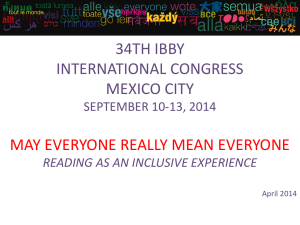The Bracero Program
advertisement
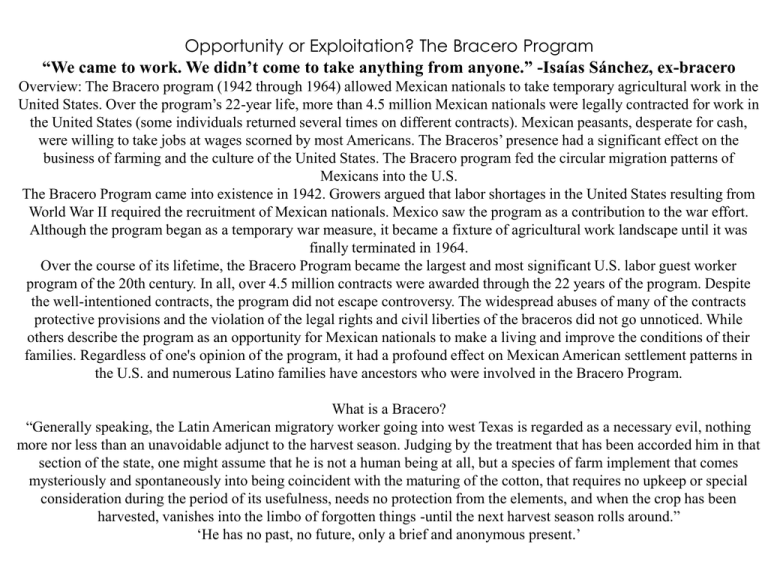
Opportunity or Exploitation? The Bracero Program “We came to work. We didn’t come to take anything from anyone.” -Isaías Sánchez, ex-bracero Overview: The Bracero program (1942 through 1964) allowed Mexican nationals to take temporary agricultural work in the United States. Over the program’s 22-year life, more than 4.5 million Mexican nationals were legally contracted for work in the United States (some individuals returned several times on different contracts). Mexican peasants, desperate for cash, were willing to take jobs at wages scorned by most Americans. The Braceros’ presence had a significant effect on the business of farming and the culture of the United States. The Bracero program fed the circular migration patterns of Mexicans into the U.S. The Bracero Program came into existence in 1942. Growers argued that labor shortages in the United States resulting from World War II required the recruitment of Mexican nationals. Mexico saw the program as a contribution to the war effort. Although the program began as a temporary war measure, it became a fixture of agricultural work landscape until it was finally terminated in 1964. Over the course of its lifetime, the Bracero Program became the largest and most significant U.S. labor guest worker program of the 20th century. In all, over 4.5 million contracts were awarded through the 22 years of the program. Despite the well-intentioned contracts, the program did not escape controversy. The widespread abuses of many of the contracts protective provisions and the violation of the legal rights and civil liberties of the braceros did not go unnoticed. While others describe the program as an opportunity for Mexican nationals to make a living and improve the conditions of their families. Regardless of one's opinion of the program, it had a profound effect on Mexican American settlement patterns in the U.S. and numerous Latino families have ancestors who were involved in the Bracero Program. What is a Bracero? “Generally speaking, the Latin American migratory worker going into west Texas is regarded as a necessary evil, nothing more nor less than an unavoidable adjunct to the harvest season. Judging by the treatment that has been accorded him in that section of the state, one might assume that he is not a human being at all, but a species of farm implement that comes mysteriously and spontaneously into being coincident with the maturing of the cotton, that requires no upkeep or special consideration during the period of its usefulness, needs no protection from the elements, and when the crop has been harvested, vanishes into the limbo of forgotten things -until the next harvest season rolls around.” ‘He has no past, no future, only a brief and anonymous present.’ Prospective Braceros Rural peasants walked long distances to collection points to sign up for Bracero contracts "As the men line up initially to be put on the list at the Control Station in Monterrey Mexico, they are kept in lines by Mexican policemen. The rubber truncheon he has in is hand is used only 'playfully' on the men, and many of them laugh at it. The groups behind the barbed wire enclosure are waiting to be called up the present their credentials." The photograph shows teams of immigration and USES (United States Employment Service) personnel processing braceros at a control stations in Mexico once approved for work in the United States. To be eligible for farm work in the United States, the bracero had to have a farm background. The photograph below shows how upon arrival to the United States, braceros were taken to processing centers where they were searched for vegetables, weapons, marijuana or similar contraband and sprayed with DDT by Department of Agriculture personnel. "Much in the same manner and feeling used in handling livestock, upon crossing over the bridge from Mexico at Hidalgo, Texas, the men are herded into groups of 100 through a makeshift booth sprayed with DDT." Bracero identification card (below) The photograph shows housing provided by contractors for braceros. Such housing included hastily converted barns, tents, and other over crowded facilities. "This is housing provided by a Texan farmer for 200 braceros in this long building, with the beds made out of stretched canvas, upper and lower. Such close living conditions make for high incidences of respiratory illnesses among the braceros." Farms and Railroads On farms, braceros worked cotton, citrus, dates, and such backbreaking stoop-labor crops as sugar beets, lettuce, and strawberries. Early in the program, they also maintained railroad tracks. Over time, braceros were sent to California, Texas, Oregon, Washington, Arkansas, and 29 other states. Contracts ranged from a few weeks to 18 months. Camps ranged in size from just a few braceros to a thousand. The photographs show braceros working the fields, where they would stay from sunrise to sunset. Thousands of braceros were brought in to perform stoop labor, a task that causes back injuries resulting from the constant strain of bending over all day. Medical clinics reported backache as the most common ailment among the braceros. Since no machine has been able to replace stoop labor, it continues today. Labor and Strife Concerns about labor issues plagued the bracero program from the start. With an eye on reducing costs and improving profits, growers saw the bracero program as a source of cheap labor. American farm workers worried that braceros would compete for their jobs and lower their wages. Many union leaders were alarmed about the use of foreign workers and how that would affect their ability to organize farm labor. "You didn’t straighten up until you reached the other side of the field." -Paulino Martínez, ex-bracero Labor Official in Mexico, handing out the contracts "Habido mucha pobreza en Mexico...yo era pobre de dinero, pobre de que comer pero rico en salud." "There was a lot of poverty in Mexico...I was money-poor, food-poor, but rich in health." -Ignacio Gomez, ex-bracero The Farm Braceros has little control over what would happen once they signed a contract. They could be sent to farms thousands of miles away with unfamiliar climates and cultures. They had to rely on the growers to provide housing, food, and medical care. Only occasionally would visiting Mexican consuls be available to help with contract or health issues. The new life braceros encountered was dramatically different from their home villages. "Yo creo que vamos a ver otro mundo. Pues era a veces hasta peor que mi rancho." "I thought we were going to see a different world. Well, sometimes it was even worse than my farm." -Santurnino González Díaz, ex-bracero "Well, on the one hand it was beneficial, and on the other hand, the family suffered just as much as you did." -Pedro del Real Pérez, ex-bracero Family The bracero program brought both economic opportunity and unexpected hardship to Mexican families. Mexico’s government hoped that workers would bring much-needed cash into their economy. Some men did earn enough money to build houses, buy land, or start businesses in Mexico. Meanwhile, families left behind while men were away had to find ways to get by without fathers, brothers, and husbands. "When the U.S. needed it most, we came to serve the United States. When the U.S. needed it most, I was here…” -José Ramírez Delgado, ex-bracero In the United States The bracero program affected communities across the United States. Some towns held dances, church services in Spanish, and other social and business events for the braceros. Many braceros never returned to Mexico. Some of them developed personal relationships, married local women, and started new families in the United States. Other towns discriminated against the braceros, barring them from restaurants and movie theaters. Even some local Mexican Americans were wary of the new workers. "Yeah, in the fields they would sing. . . . Thirty, forty, or fifty . . . . No, life was hard, very hard, and beautiful." -Ismael Díaz de León, ex-bracero On The Farm Braceros’ experiences differed depending on where they lived and worked. On isolated farms far from towns, the men were often forced to be self-sufficient — cooking, cutting hair, doing laundry, and sharing domestic chores. Larger camps often provided food and some sort of entertainment. No matter where they were, braceros created an informal network that helped each other deal with camp life. "Over here your life changed because you earned more money, you could buy more things that you wanted, buy clothes, eat better. For me it was a positive experience. Maybe some would say not." -Audómaro G. Zepeda, ex-bracero Beyond Borders As popular culture, business, and labor have brought U.S. influence to every corner of Mexico, so have Mexican labor, culture, and religious practices influenced the U.S. Although bracero workers were supposed to return to Mexico at the end of their contracts, not all did. Many who returned to Mexico later emigrated to the U.S., aided by the experience and knowledge they had gained as braceros. Today, numerous families and communities can trace their histories to the bracero program. "Well, the term bracero . . . it is a word of distinction, for me it is a word of great pride. I would like that word to go down in history." -Juan Loza, ex-bracero Legacy The bracero experience was one of exploitation but also of opportunity. The program had a direct impact on immigration and labor policy and, more importantly, on the formation of thriving Mexican American communities here in the U.S. With its legacy of struggle and success, the story of the bracero program was truly bittersweet

